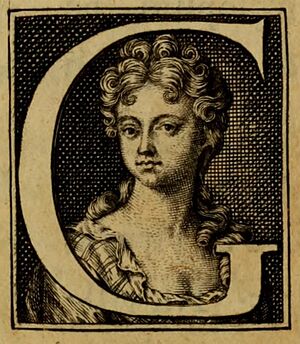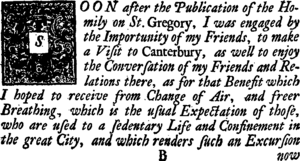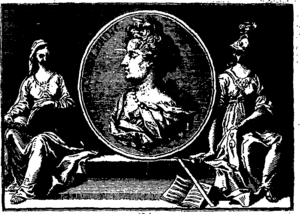Elizabeth Elstob facts for kids
Elizabeth Elstob (born 29 September 1683 – died 3 June 1756) was an amazing scholar from a long time ago. She was known as the "Saxon Nymph" because she was so good at studying the Anglo-Saxons, who lived in England many centuries ago. Elizabeth was the first person to publish a grammar book about Old English (the language spoken by Anglo-Saxons) that was written in modern English. This was a huge achievement!
Her Early Life and Learning
Elizabeth Elstob was born in Newcastle upon Tyne, a city in England. She is seen today as one of the first English "protofeminists." This means she believed women should have the chance to learn and achieve great things, even before the idea of feminism was common.
Elizabeth's father passed away when she was five. Her mother died three years later. Elizabeth was the youngest of eight children. Before her mother died, she encouraged Elizabeth to study. Her mother truly believed in learning, especially for girls. By the age of eight, Elizabeth was already very good at Latin.
Elizabeth became skilled in eight different languages. She was a leader in studying Anglo-Saxon history and language. This was an incredible feat for a woman during her time. After her parents died, Elizabeth was raised by her aunt and uncle. Her uncle thought that "one tongue is enough for a woman." He didn't believe girls should get much education. However, her aunt secretly helped her learn French.
Most of Elizabeth's education came from her brother, William Elstob. He was also a scholar. Elizabeth lived with him in Oxford starting in 1696. Later, they moved to London in 1702. As a teenager, William introduced Elizabeth to a small group of scholars. They were all very interested in Anglo-Saxon history and culture. William called Elizabeth "the delightful and tireless companion of my studies."
Her Amazing Scholarly Work
Elizabeth was very interested in early English. She worked with other scholars like Humfrey Wanley and George Hickes. Her brother William introduced her to Hickes. Elizabeth even helped design the special letters for her 1715 book, Rudiments of Grammar for the English-Saxon Tongue. She was also a talented copyist and could make exact copies of old texts. Her copy of an old book called the Textus Roffensis is kept at the British Library today.
Elizabeth was the first person to edit the Old-English Orosius. This was a translation of a history book written by Paulus Orosius. Many people believe Alfred the Great, a famous English king, translated it into Old English.
In London, Elizabeth translated a book called Essay upon Glory in 1708. She also translated an English-Saxon Homily on the Nativity of St Gregory in 1709. Both of these books were dedicated to Queen Anne. Elizabeth praised the Queen in the introductions, which also shared her ideas about women's learning.
From 1702, Elizabeth was part of a group of smart women led by Mary Astell. This group helped Elizabeth find people to buy her Rudiments of Grammar for the English-Saxon Tongue (published in 1715). The introduction to her book, called "An Apology for the Study of Northern Antiquities," disagreed with some ideas from a famous writer named Jonathan Swift. It seems her arguments even made him change his mind!
Later Life and Challenges
After her brother William died in 1715, Elizabeth faced many difficulties. She lost her home and had many debts from the expensive books they had published. She tried to open a girls' school in Chelsea. She had so many students that she "scarcely time to eat." However, the students only paid a very small amount each week. The school failed within six months.
In 1718, Elizabeth left London to escape her debts. She had to leave behind her books and a partial translation of an important manuscript. This translation was never published. She also gave her other papers to a friend who later moved far away, and the papers were lost.
Elizabeth ended up living in Evesham, a small town in the countryside. She lived there for many years, relying on her friends. She ran a small school for children under the made-up name Frances Smith. No one in the scholarly world knew where she was until 1735.
In 1738, Elizabeth met a very wealthy woman named Margaret Bentinck, Duchess of Portland. Elizabeth became a governess (a private teacher) for the Duchess's children. She stayed in this job until she passed away on 3 June 1756. In her final years, she was surrounded by her beloved books. She once wrote that her time was "not an Age to hope for any encouragement to Learning of any kind."
Elizabeth Elstob was buried in the churchyard of St Margaret's, Westminster.




